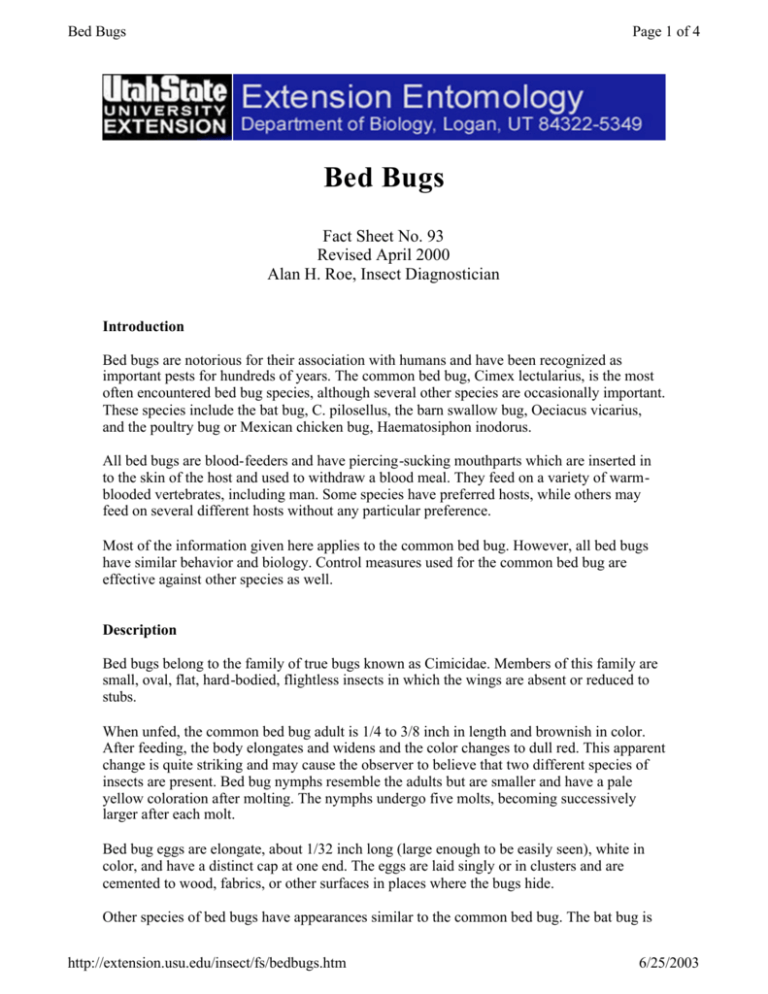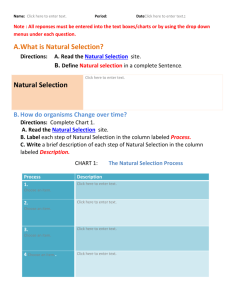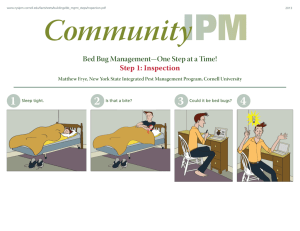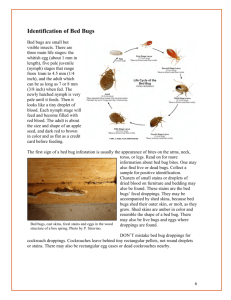Bed Bugs
advertisement

Bed Bugs Page 1 of 4 Bed Bugs Fact Sheet No. 93 Revised April 2000 Alan H. Roe, Insect Diagnostician Introduction Bed bugs are notorious for their association with humans and have been recognized as important pests for hundreds of years. The common bed bug, Cimex lectularius, is the most often encountered bed bug species, although several other species are occasionally important. These species include the bat bug, C. pilosellus, the barn swallow bug, Oeciacus vicarius, and the poultry bug or Mexican chicken bug, Haematosiphon inodorus. All bed bugs are blood-feeders and have piercing-sucking mouthparts which are inserted in to the skin of the host and used to withdraw a blood meal. They feed on a variety of warmblooded vertebrates, including man. Some species have preferred hosts, while others may feed on several different hosts without any particular preference. Most of the information given here applies to the common bed bug. However, all bed bugs have similar behavior and biology. Control measures used for the common bed bug are effective against other species as well. Description Bed bugs belong to the family of true bugs known as Cimicidae. Members of this family are small, oval, flat, hard-bodied, flightless insects in which the wings are absent or reduced to stubs. When unfed, the common bed bug adult is 1/4 to 3/8 inch in length and brownish in color. After feeding, the body elongates and widens and the color changes to dull red. This apparent change is quite striking and may cause the observer to believe that two different species of insects are present. Bed bug nymphs resemble the adults but are smaller and have a pale yellow coloration after molting. The nymphs undergo five molts, becoming successively larger after each molt. Bed bug eggs are elongate, about 1/32 inch long (large enough to be easily seen), white in color, and have a distinct cap at one end. The eggs are laid singly or in clusters and are cemented to wood, fabrics, or other surfaces in places where the bugs hide. Other species of bed bugs have appearances similar to the common bed bug. The bat bug is http://extension.usu.edu/insect/fs/bedbugs.htm 6/25/2003 Bed Bugs Page 2 of 4 virtually identical but is parasitic upon bats. The barn swallow bug is similar in size and coloration but is clothed with long silky hairs. The poultry bug or Mexican chicken bug is more active than the common bed bug, has longer legs, and a longer beak. Life Cycle Bed bugs are capable of producing up to four generations per year, although one or two generations is the usual number. Development time depends on temperature and food supply, and breeding can occur throughout the year in warmer regions or in colder regions where rooms are kept uniformly heated during winter. Egg laying activity is suspended during winter if rooms are allowed to cool, but adults or nymphs can still overwinter under these conditions. Since some bed bug nymphs may feed more successfully than others, development time may vary greatly even among nymphs from the same generation. For this reason, both adults and nymphs will usually be present throughout the year. Each female bed bug lays 50 to 200 eggs at the rate of 3 or 4 eggs per day. At temperatures above 70 degrees Fahrenheit, egg hatch occurs in 6 to 17 days. Hatching may take up to 28 days at lower temperatures. Development to the adult stage may occur in as little as one or two months, but usually takes longer. Feeding Behavior Bed bugs are nocturnal insects and emerge from their hiding places at night to feed on nearby hosts. They may occasionally feed during the day if very hungry and lighting conditions are dim. Hosts of the common bed bug include man, mice, rats, rabbits, guinea pigs, horses, cattle, and poultry. Young and adults of both sexes feed exclusively upon blood. The bugs pierce the skin of the host and withdraw blood with their beak-like mouthparts. The bugs prefer to be in enclosed places and often feed in areas where clothing is held tightly against the skin, such as underneath the waistband of pajamas. The bite is usually not felt at first but later may itch, swell, burn, become inflamed, or form a welt. Effects of a bite vary with the individual but may persist for a week or more in susceptible persons. There is no evidence that bed bugs transmit any diseases, at least within the United States. Bed bugs may feed on small animals kept as pets or upon laboratory animals, and blood loss due to their feeding may weaken such animals. In poultry houses, sitting hens may be driven from their nests by bed bug attacks. A given bed bug individual usually does not feed every night but at intervals of a few days to a week. Newly hatched nymphs will feed as soon as possible, then usually feed once between each molt. If left undisturbed, a bed bug can obtain a full blood meal in 3 to 5 minutes. Bed bugs can live for 4 to 12 months without feeding. The bugs will survive longer without a meal at lower temperatures than at higher temperatures. http://extension.usu.edu/insect/fs/bedbugs.htm 6/25/2003 Bed Bugs Page 3 of 4 Sources and Detection of Infestations Bed bugs may be found in many situations, including homes, hotels, poultry houses, around laboratory animals or small caged pets, or near bird and bat nests and roosts. Bed bugs often find their way into the luggage of travelers and may be transported and spread in this manner. If the occupants of a home or apartment infested with bed bugs move out, the bugs may migrate to other nearby dwellings. Similarly, they may occasionally enter homes after a bird or bat control program has eliminated their normal hosts, and are sometimes unknowingly carried into the home from poultry houses. Infestations of bed bugs can often be detected by the offensive odor associated with them. The odor is caused by an oily secretion produced from special glands, and has been described as a smell resembling that of "old dirty laundry" in light infestations, becoming even more objectionable in heavy infestations. In a light infestation, bed bugs will be found in the tufts, seams, and folds of mattresses and covers, later spreading to crevices in the bed frame and box springs. In severe infestations the bugs will also be found behind baseboards, window and door casings, picture moldings, loosened wallpaper, cracked plaster, or in furniture. Brown or black spots of dried excrement found around hiding places or in bedding is also an indication of bed bug infestations. Eggs, egg shells, and molted skins may often be found in the bed bugs' hiding places. The masked hunter, an assassin bug, is known to feed upon bed bugs. Presence of this insect in the home may be indicative of bed bug infestations, although this is not always the case since these assassin bugs may enter homes anyway. Bed Bug Control The majority of insecticides currently labeled for bed bug control in indoor domestic dwelling situations contain either pyrethrins or synthetic pyrethroids. These include formulations containing allethrin, deltamethrin, D-phenothrin, lambda-cyhalothrin, permethrin, pyrethrins, resmethrin, and tetramethrin. Among products for homeowners this is especially the case, although a few other types of insecticides are available. Non-pyrethrinderivative ingredients include benzylcarbinyl propionate plus eugenol, carbaryl (Sevin), chlorpyrifos (Dursban), diatomaceous earth, silica gel, and S-methoprene, some of which are available only in formulations intended for commerical applicators. Fumigants (intended only for use by commercial applicators in vacated structures) include methyl bromide, and sulfuryl fluoride (Vikane). All of these fumigants are Restricted-UsePesticides and are inherently dangerous. Special training and equipment is required to legally purchase and use these fumigants. Bed bug control in the home begins with location of the hiding places used by the insects. A thorough inspection should be made during the day and all hiding places that are located should be treated with a suitable chemical. Ideally, an insecticide spray should be applied to to the slats, springs, and frame of the bed. http://extension.usu.edu/insect/fs/bedbugs.htm 6/25/2003 Bed Bugs Page 4 of 4 Do not treat mattresses or bedding directly unless the product you use is specifically labeled for this purpose! Such items should be sprayed lightly, but not to the point of wetness. Allow mattresses or other bedding to dry thoroughly before using. Brush or spray applications of insecticides should be made to baseboards, wall cracks, and other hiding areas that may harbor bed bugs. Because they degrade rapidly, applications of insecticides containing pyrethrins should be repeated several times at weekly intervals. Other pyrethroids have varying degrees of residual action and can probably be applied less often (consult the label of the specific product). Infestations in hotels, apartments, condominiums, or other multiple dwellings, as well as heavy infestations in private homes, are often best left to a professional pest exterminator. Because of the bed bug's ability to migrate, all units in a multiple dwelling must be inspected, treated where necessary, and periodically checked for reinfestations until all of the bugs are eliminated. Reinfestations in these situations may also occur when new occupants or residents bring in bed bug-infested belongings or furniture. The choices of insecticides for use in hotels, motels, and tourist courts are more limited than those for use in domestic dwellings, but there are still dozens of products available. Bed bug control around animals also involves location and treatment of the bed bugs' hiding places. In poultry houses, bed bugs hide and breed in nests, behind nest boxes, under loose boards, or in cracks in the walls, roosts, and roof. Black spots of bed bug excrement may be evident on eggs or in cracks around nests. The bugs are almost never found on fowl in the daytime. Special precautions may be required when treating near laboratory animals if pesticide residues are a concern. Care should be taken not to apply insecticides directly to poultry or other animals unless the products are specifically labeled for this purpose. Precautionary Statement All pesticides have both benefits and risks. Benefits can be maximized and risks minimized by reading and following the labeling. Pay close attention to the directions for use and the precautionary statements. The information on pesticide labels contains both instructions and limitations. Pesticide labels are legal documents, and it is a violation of both federal and state laws to use a pesticide inconsistent with its labeling. The pesticide applicator is legally responsible for proper use. Always read and follow the label. http://extension.usu.edu/insect/fs/bedbugs.htm 6/25/2003







